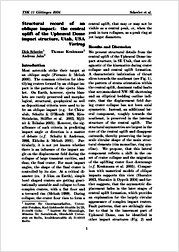| dc.contributor.author | Scherler, Dirk | |
| dc.contributor.author | Kenkmann, Thomas | |
| dc.contributor.author | Jahn, Andreas | |
| dc.contributor.editor | Philipp, Sonja | |
| dc.contributor.editor | Leiss, Bernd | |
| dc.contributor.editor | Vollbrecht, Axel | |
| dc.contributor.editor | Tanner, David | |
| dc.contributor.editor | Gudmundsson, Agust | |
| dc.date.accessioned | 2010-11-26T13:21:37Z | |
| dc.date.accessioned | 2013-01-28T10:20:13Z | |
| dc.date.available | 2010-11-26T13:21:37Z | |
| dc.date.available | 2013-01-28T10:20:13Z | |
| dc.date.issued | 2006-03 | |
| dc.identifier.citation | Philipp, S.; Leiss, B; Vollbrecht, A.; Tanner, D.; Gudmundsson, A. (eds.): 11. Symposium "Tektonik, Struktur- und Kristallingeologie"; 2006, Univ.-Verl. Göttingen, p. 188 - 191. | |
| dc.identifier.isbn | 3-938616-40-7 | |
| dc.identifier.uri | http://hdl.handle.net/11858/00-1735-0000-0001-347B-5 | |
| dc.description.abstract | Most asteroids strike their target at
an oblique angle (Pierazzo & Melosh
2000). The common criterion for identifying
craters formed by an oblique impact
is the pattern of the ejecta blanket.
On Earth, however, ejecta blankets
are rarely preserved and morphological,
structural, geophysical as well
as depositional criteria were used to infer
an oblique impact (e.g. for Chicxulub,
Schultz & D’Hondt 1996, Ries-
Steinheim, Stöffler et al. 2003, Mjölnir
& Tsikalas 2005). However, the significance
of such criteria in predicting
impact angle or direction is a matter
of debate (c.f. Schultz & Anderson,
1996, Ekholm & Melosh 2001). Particularly,
it is not yet known whether
there is an influence of the impact angle
on the displacement field during the
collapse of large transient cavities, and
thus, the final crater. For most impact
angles, the shape of the final crater is
controlled by its size. At a critical diameter
(ca. 2–5 km on Earth), simple
bowl shaped craters are getting gravitationally unstable and collapse to form
complex craters, with a flat floor and
a terraced rim (Melosh 1989). During
collapse, the crater floor rises to form a central uplift, that may or may not be
visible as a central peak, or, when the
peak in turn collapses, as a peak ring at
yet larger diameters. | |
| dc.format.mimetype | application/pdf | |
| dc.language.iso | deu | |
| dc.publisher | Universitätsverlag Göttingen | |
| dc.relation.ispartof | 11. Symposium "Tektonik, Struktur- und Kristallingeologie" | |
| dc.subject.ddc | 551 | |
| dc.subject.gok | VAE 150 | |
| dc.subject.gok | VAX 000 | |
| dc.subject.gok | VEV 277 | |
| dc.title | Structural record of an oblique impact: the central uplift of the Upheaval Dome impact structure, Utah, USA | |
| dc.type | anthologyArticle | |
| dc.subject.gokverbal | Strukturelle Erscheinungen {Strukturgeologie} | |
| dc.subject.gokverbal | Akkretion extraterrestrischen Materials {Geologie} | |
| dc.subject.gokverbal | Utah {Geologie} | |
| dc.bibliographicCitation.firstPage | 188 | |
| dc.bibliographicCitation.lastPage | 191 | |
| dc.identifier.doi | 10.23689/fidgeo-1874 | |
| dc.type.version | publishedVersion | |
| dc.subject.free | Utah <Südost> | |
| dc.subject.free | Impaktstruktur | |
| dc.subject.free | Strukturgeologie | |
| dc.relation.collection | Geologische Wissenschaften | |
| dc.description.type | conference | |


